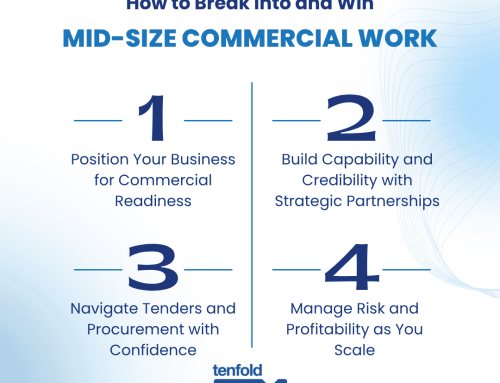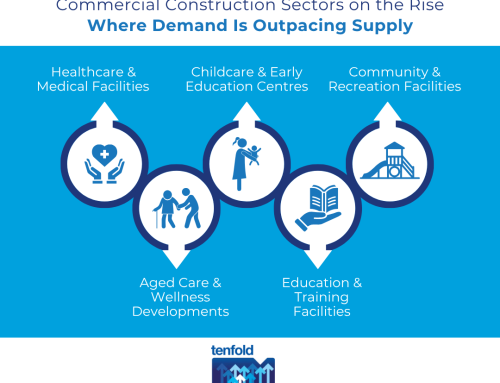The New Growth Frontier in Mid-Size Commercial Construction
Australia’s construction industry is currently experiencing a significant transformation. For many years, the focus was primarily on residential housing, which saw steady growth. However, recent developments indicate a change in this trend. Approvals for detached houses have slowed down noticeably, and new apartment projects are facing delays or cancellations. Builders are dealing with narrower profit margins and less predictable project pipelines. Despite this slowdown, a new opportunity is beginning to surface: the construction of mid-sized commercial buildings. For residential builders, this moment represents a unique and potentially lucrative chance for sustainable growth and diversification.
According to the Australian Bureau of Statistics, non-residential building approvals have surged in recent quarters, with medical centres, education facilities, and community infrastructure leading the charge. This pivot reflects broader economic and demographic trends. Population growth, urban expansion, and increased government investment are fuelling demand for localised services and infrastructure. Builders who once focused solely on homes are now eyeing commercial projects valued between $2 million and $15 million, and with the right business coaching, they’re well-positioned to succeed.
Defining the Opportunity: What Is Mid-Size Commercial Construction?
Mid-size commercial construction occupies a unique position in the industry. These types of projects are large enough to necessitate professional project management and the use of skilled tradespeople, yet they are small enough to bypass the extensive red tape and complex corporate procedures typically associated with large-scale developments. Examples include medical clinics, childcare centres, primary schools, sports pavilions, and aged care facilities. Such buildings are often designed with the community in mind, usually funded by a combination of government grants as well as private investments. They are primarily built to serve the needs of growing suburbs and regional centres, supporting local populations and contributing to community development.
For builders operating within the Australian construction industry, this particular segment presents a compelling blend of challenges and opportunities. The work involved is quite technically demanding, requiring a solid understanding of compliance standards set by local regulations and effective coordination with various stakeholders, including clients, subcontractors, and suppliers. Unlike large-scale high-rise towers or extensive infrastructure megaprojects, mid-sized commercial building projects in Australia tend to offer greater autonomy to the builders. This results in a faster turnaround time on projects and fosters more direct relationships with clients, which can be highly beneficial.
Why This Segment Is Growing: Insights from Next Level Business Coaching
The rise of mid-sized commercial construction projects is not a coincidence. It results from several converging factors that business coaches are particularly well-equipped to help builders understand and take advantage of. Firstly, the population of Australia continues to grow steadily, especially in outer metropolitan and regional areas. These communities have an urgent need for new schools, health clinics, and recreational facilities, and they require them quickly to support their expanding populations.
Second, both state and federal governments are investing heavily in social infrastructure. For example, Victoria’s Big Build and Queensland’s health precinct expansions are receiving significant funding. These projects aim to enhance the quality of life for residents and bolster local economies across Australia. Private developers are also playing an increasingly vital role, particularly in sectors such as aged care and early childhood education, where the demand for services is growing faster than the supply. This coordinated effort between government and private sector investment underscores a strong commitment to building resilient communities and supporting Australia’s social infrastructure needs.
Third, the construction industry itself is in the process of recalibrating and adapting to new challenges. As large-scale residential development projects become increasingly risky and less financially viable, builders and developers are actively seeking alternative avenues for growth and stability. One such avenue is mid-sized commercial construction work, which tends to offer stronger profit margins, more reliable project pipelines, and a lower risk of insolvency for those involved. Additionally, with the help of tailored business coaching and mentoring, builders can learn to prepare more competitive bids, effectively manage the complexities associated with different projects, and cultivate long-lasting relationships with institutional clients and stakeholders in the industry.
Why Residential Builders Are Perfectly Placed: A Business Coach’s Perspective
Experienced residential builders already possess many of the skills needed to thrive in mid-size commercial construction. They understand site supervision, client liaison, and project scheduling. They know how to manage trades, navigate compliance, and deliver quality outcomes. What they often lack is strategic insight – and that’s where next level business coaching comes in.
Business coaches can help builders to reframe their capabilities, identify skills that are transferable to new contexts, and develop innovative systems for estimating projects, tendering processes, and engaging with stakeholders effectively. They can also provide guidance to help builders adopt the necessary mindset shift, moving from primarily consumer-facing work to more complex institutional projects. With the right support, builders have the opportunity to diversify their portfolios, stabilise their cash flow, and future-proof their businesses against market changes and challenges in the Australian construction industry.
Importantly, mid-size commercial work tends to be less volatile than residential work. Approvals are more predictable, funding is more secure, and clients tend to be more professional. This creates a fertile ground for long-term growth, especially for builders who are willing to invest in business coaching services that help them scale their operations with confidence.
Setting the Stage: What’s Next in This Series From a Business Coach
This article marks the beginning of a three-part series designed to assist builders in navigating the transition towards mid-sized commercial construction projects. In Part Two, we will explore the sectors where demand is experiencing significant growth, including healthcare, education, and community sports facilities. We will investigate what factors are driving growth in each of these areas, the types of projects that are currently being funded, and where the most promising opportunities can be found for businesses looking to expand their presence in the market.
In Part Three, we will demonstrate to builders how to make the necessary leap forward in their projects and business practices. We will comprehensively cover a wide range of topics, including how to develop capability statements, create effective compliance checklists, develop tendering strategies, and organise team structures.
Whether you’re an experienced residential builder looking to diversify your portfolio or future-proof your business, this series will equip you with the insights and practical tools to succeed in Australia’s evolving construction landscape. To explore how tailored business coaching can support your next move, contact Tenfold Business Coaching and take the first step toward smarter, more strategic growth.
FAQs: Business Coaching Insights for Builders
What defines a “mid-size” commercial construction project?
Typically, these are construction projects valued between two million and fifteen million Australian dollars. They include medical centres, childcare facilities, schools, sports pavilions, and aged care facilities. These projects are substantial enough to require professional oversight, but they are not so large that they would involve the complex layers of corporate bureaucracy often associated with larger developments.
Why are residential builders moving into the commercial sector?
Residential profit margins have become narrower, and the sequence of upcoming projects has become more uncertain and difficult to predict. Work involving medium-sized commercial projects tends to offer more favourable profit margins, a more consistent level of demand, and opportunities to utilise existing skills in a different and often innovative context. This shift highlights the importance of adaptability and strategic planning in navigating current market conditions.
What’s driving growth in commercial construction right now?
Population growth, urban expansion, and government investment serve as key drivers of development in Australia. As cities and towns continue to grow, communities increasingly require improved infrastructure to support their needs. To meet this demand, both the public sector (comprising government agencies and local councils) and the private sector are actively funding and implementing a variety of projects. These initiatives aim to enhance transportation, utilities, healthcare, education, and other essential services, ensuring sustainable development and improved quality of life across Australian communities.
Are mid-size commercial projects more profitable than residential builds?
In many cases, yes. These projects tend to have clearer scopes, more professional clients, and better funding security. With the right business coaching, builders can learn to manage them efficiently and profitably. To put it simply, when projects are well-defined and backed by reliable financiers, builders have a much easier time delivering successful outcomes. With the appropriate guidance and coaching tailored to Australian business practices, builders can develop the skills needed to handle such projects with confidence and ease.
Which states are seeing the strongest demand for these projects?
Growth is particularly strong in the states of Victoria, Queensland, and New South Wales, where the pressures from increasing populations are significant and investment in infrastructure is at its highest. Additionally, regional centres across the country are experiencing a rise in activity, especially in sectors such as health and education, reflecting broader development trends.
Table of Contents
- Defining the Opportunity: What Is Mid-Size Commercial Construction?
- Why This Segment Is Growing: Insights from Next Level Business Coaching
- Why Residential Builders Are Perfectly Placed: A Business Coach’s Perspective
- Setting the Stage: What’s Next in This Series From a Business Coach
- FAQs: Business Coaching Insights for Builders
- What defines a “mid-size” commercial construction project?
- Why are residential builders moving into the commercial sector?
- What’s driving growth in commercial construction right now?
- Are mid-size commercial projects more profitable than residential builds?
- Which states are seeing the strongest demand for these projects?






